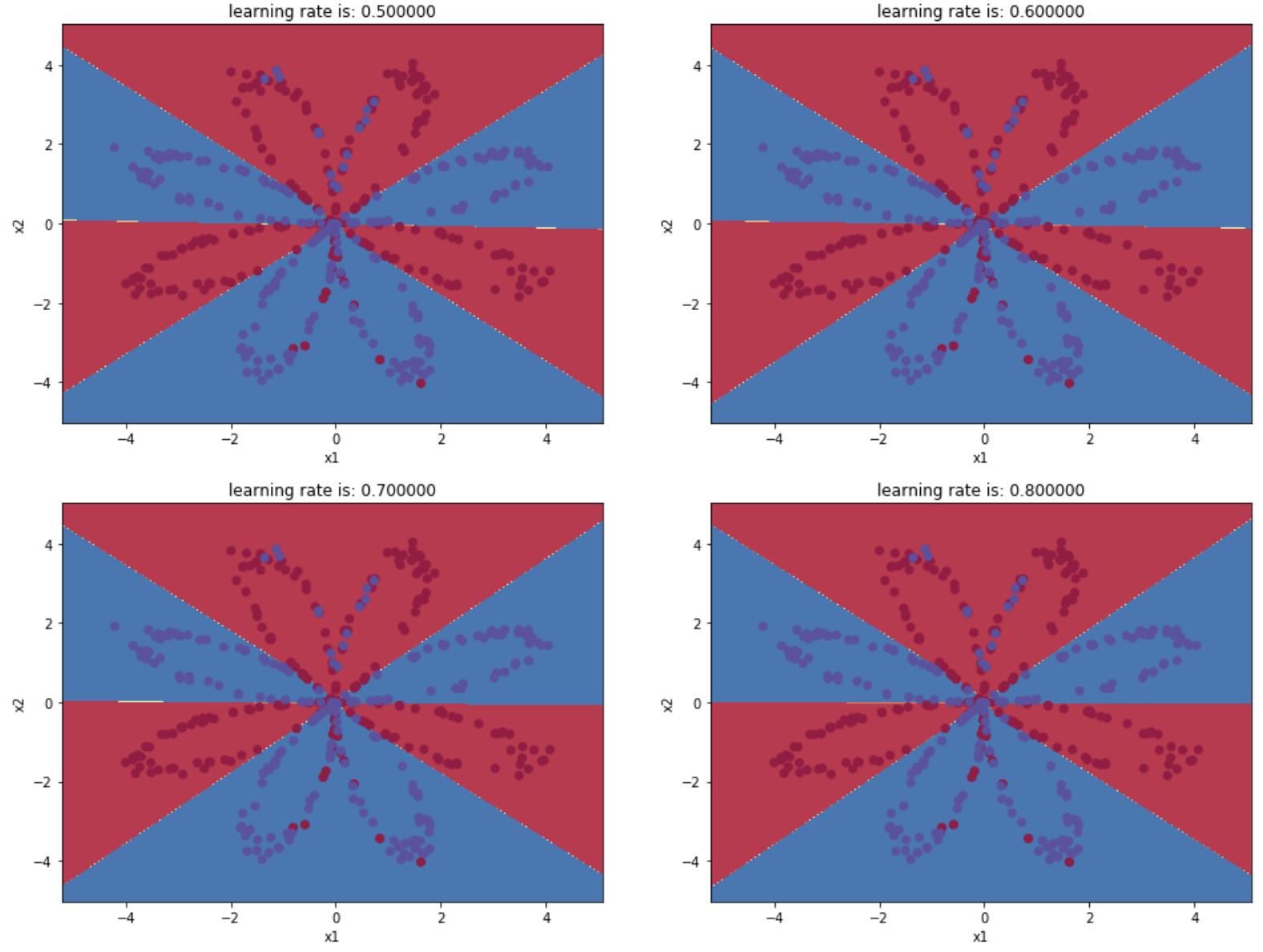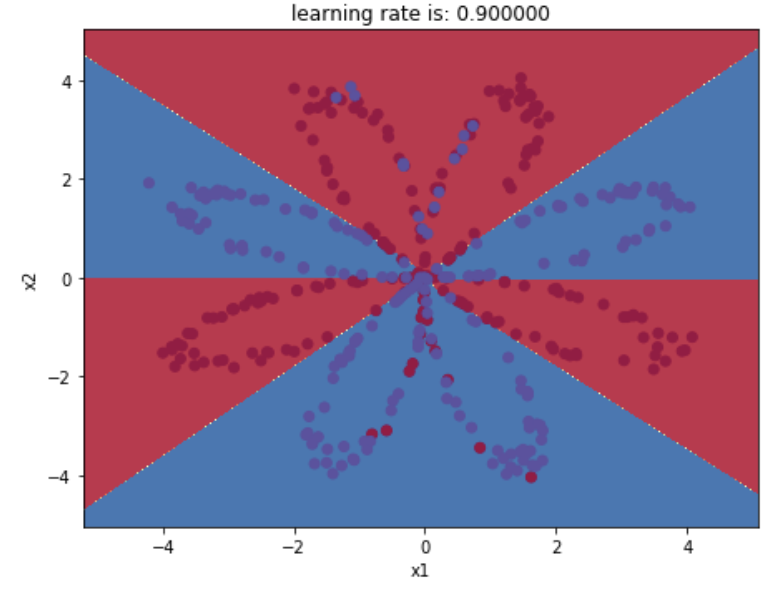参考:https://blog.csdn.net/u013733326/article/details/79702148
希望大家直接到上面的网址去查看代码,下面是本人的笔记
建立一个带有隐藏层的神经网络
导入一些软件包
numpy:是用Python进行科学计算的基本软件包。
sklearn:为数据挖掘和数据分析提供的简单高效的工具。
matplotlib :是一个用于在Python中绘制图表的库。
testCases:提供了一些测试示例来评估函数的正确性,参见下载的资料或者在底部查看它的代码。
planar_utils :提供了在这个任务中使用的各种有用的功能,参见下载的资料或者在底部查看它的代码。
1.导入数据:
numpy.linspace(start, stop[, num=50[, endpoint=True[, retstep=False[, dtype=None]]]]])
返回在指定范围内的均匀间隔的数字(组成的数组),也即返回一个等差数列,参数说明:
- start - 起始点
- stop - 结束点
- num - 元素个数,默认为50,
- endpoint - 是否包含stop数值,默认为True,包含stop值;若为False,则不包含stop值
- retstep - 返回值形式,默认为False,返回等差数列组,若为True,则返回结果(array([`samples`]),`step`),
- dtype - 返回结果的数据类型,默认无,若无,则参考输入数据类型。
举例说明:
c = np.linspace(1,15,5,endpoint= False,retstep = False) print(c) #[ 1. 3.8 6.6 9.4 12.2] d = np.linspace(1,15,5,retstep = True) print(d) #(array([ 1. , 4.5, 8. , 11.5, 15. ]), 3.5)
代码:
import numpy as np import matplotlib.pyplot as plt import sklearn import sklearn.datasets import sklearn.linear_model #要使用的数据集, 下面的代码会将一个花的图案的2类数据集加载到变量X和Y中。 def load_planar_dataset(): np.random.seed(1) m = 400 # number of examples N = int(m/2) # number of points per class D = 2 # dimensionality X = np.zeros((m,D)) # m=400个点,每个点使用(x,y)表示,所以D=2,因此生成一个400*2的数据矩阵 Y = np.zeros((m,1), dtype='uint8') # 标签向量,表明每个点的类型,0为红色,1位蓝色 a = 4 # maximum ray of the flower for j in range(2): ix = range(N*j,N*(j+1)) #(0,200)和(200,400) t = np.linspace(j*3.12,(j+1)*3.12,N) + np.random.randn(N)*0.2 # theta r = a*np.sin(4*t) + np.random.randn(N)*0.2 # radius X[ix] = np.c_[r*np.sin(t), r*np.cos(t)] Y[ix] = j X = X.T Y = Y.T return X, Y X, Y = load_planar_dataset() plt.scatter(X[0, :], X[1, :], c=np.squeeze(Y), s=40, cmap=plt.cm.Spectral)#绘制散点图
返回:
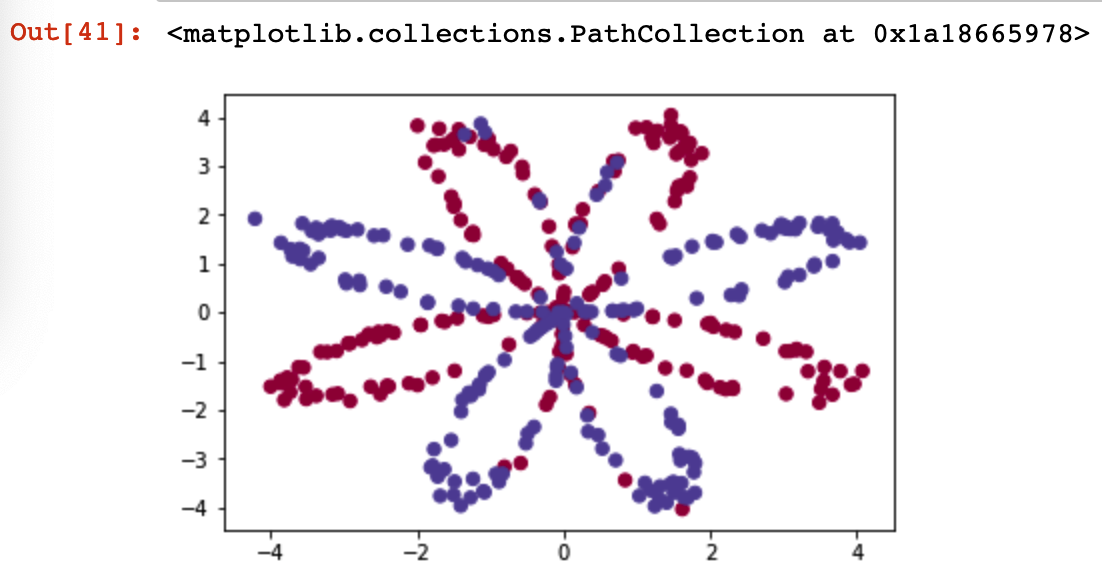
该神经网络的目标是建立一个模型来适应这些数据,将蓝色的点和红色的点分隔开来
- X:一个numpy的矩阵,包含了这些数据点的数值
- Y:一个numpy的向量,对应着的是X的标签【0 | 1】(红色:0 , 蓝色 :1)
2.如果试着使用logistic回归来进行分类
在构建完整的神经网络之前,先让我们看看逻辑回归在这个问题上的表现如何,我们可以使用sklearn的内置函数来做到这一点, 运行下面的代码来训练数据集上的逻辑回归分类器。
clf = sklearn.linear_model.LogisticRegressionCV()
clf.fit(X.T,Y.T)
会有警告:
/anaconda3/lib/python3.7/site-packages/sklearn/utils/validation.py:761: DataConversionWarning: A column-vector y was passed when a 1d array was expected. Please change the shape of y to (n_samples, ), for example using ravel(). y = column_or_1d(y, warn=True) /anaconda3/lib/python3.7/site-packages/sklearn/model_selection/_split.py:2053: FutureWarning: You should specify a value for 'cv' instead of relying on the default value. The default value will change from 3 to 5 in version 0.22. warnings.warn(CV_WARNING, FutureWarning)
返回:
LogisticRegressionCV(Cs=10, class_weight=None, cv='warn', dual=False, fit_intercept=True, intercept_scaling=1.0, max_iter=100, multi_class='warn', n_jobs=None, penalty='l2', random_state=None, refit=True, scoring=None, solver='lbfgs', tol=0.0001, verbose=0)
然后把逻辑回归分类器的分类绘制出来:
def plot_decision_boundary(model, X, y): #用于绘制logistic的线形分类线 # Set min and max values and give it some padding x_min, x_max = X[0, :].min() - 1, X[0, :].max() + 1 y_min, y_max = X[1, :].min() - 1, X[1, :].max() + 1 h = 0.01 # Generate a grid of points with distance h between them xx, yy = np.meshgrid(np.arange(x_min, x_max, h), np.arange(y_min, y_max, h)) # Predict the function value for the whole grid Z = model(np.c_[xx.ravel(), yy.ravel()]) Z = Z.reshape(xx.shape) # Plot the contour and training examples plt.contourf(xx, yy, Z, cmap=plt.cm.Spectral) plt.ylabel('x2') plt.xlabel('x1') plt.scatter(X[0, :], X[1, :], c=np.squeeze(y), cmap=plt.cm.Spectral) plot_decision_boundary(lambda x: clf.predict(x), X, Y) #绘制决策边界 plt.title("Logistic Regression") #图标题 LR_predictions = clf.predict(X.T) #预测结果 print ("逻辑回归的准确性: %d " % float((np.dot(Y, LR_predictions) + np.dot(1 - Y,1 - LR_predictions)) / float(Y.size) * 100) + "% " + "(正确标记的数据点所占的百分比)")
返回:
逻辑回归的准确性: 47 % (正确标记的数据点所占的百分比)
图示为:
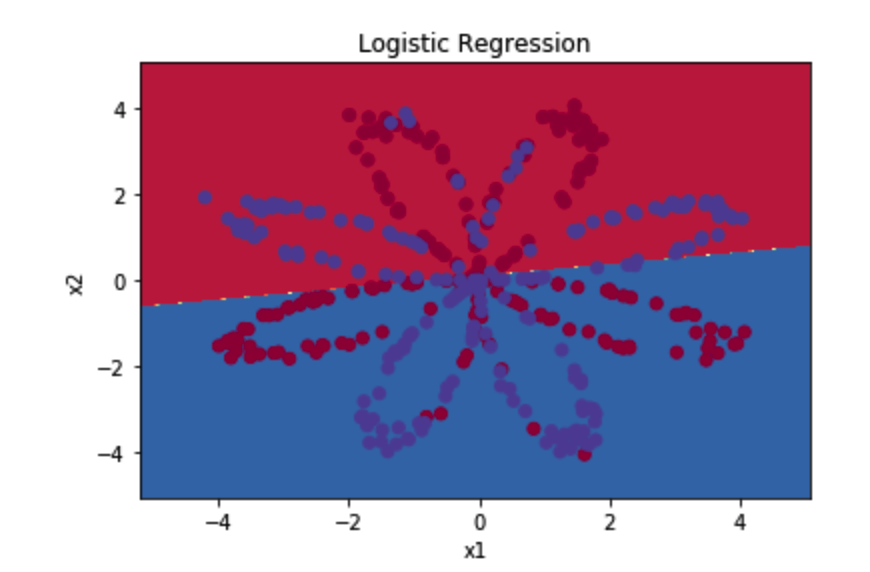
准确性只有47%的原因是数据集不是线性可分的,所以逻辑回归表现不佳,现在我们正式开始构建带有一层隐藏层的神经网络。
3.定义神经网络结构
隐藏层的神经元设置为4
def layer_sizes(X , Y): """ 参数: X - 输入数据集,维度为(输入的数量,训练/测试的数量) Y - 标签,维度为(输出的数量,训练/测试数量) 返回: n_x - 输入层的数量 n_h - 隐藏层的数量 n_y - 输出层的数量 """ n_x = X.shape[0] #输入层 n_h = 4 #,隐藏层,硬编码为4 n_y = Y.shape[0] #输出层 return (n_x,n_h,n_y) #测试layer_sizes print("=========================测试layer_sizes=========================") def layer_sizes_test_case(): np.random.seed(1) X_assess = np.random.randn(5, 3) #5个输入,训练/测试的数量为3 Y_assess = np.random.randn(2, 3) #2个输出,训练/测试的数量为3 return X_assess, Y_assess X_asses , Y_asses = layer_sizes_test_case() (n_x,n_h,n_y) = layer_sizes(X_asses,Y_asses) print("输入层的节点数量为: n_x = " + str(n_x)) print("隐藏层的节点数量为: n_h = " + str(n_h)) print("输出层的节点数量为: n_y = " + str(n_y))
返回:
=========================测试layer_sizes========================= 输入层的节点数量为: n_x = 5 隐藏层的节点数量为: n_h = 4 输出层的节点数量为: n_y = 2
4.初始化模型参数
进行随机初始化权重矩阵:
np.random.randn(a,b)* 0.01来随机初始化一个维度为(a,b)的矩阵。
将b初始化为零
np.random.seed(2)的作用是用于保证你得到的随机参数和作者的一样
def initialize_parameters( n_x , n_h ,n_y): """ 参数: n_x - 输入层节点的数量 n_h - 隐藏层节点的数量 n_y - 输出层节点的数量 返回: parameters - 包含参数的字典: W1 - 权重矩阵,维度为(n_h,n_x) b1 - 偏向量,维度为(n_h,1) W2 - 权重矩阵,维度为(n_y,n_h) b2 - 偏向量,维度为(n_y,1) """ np.random.seed(2) #指定一个随机种子,以便你的输出与我们的一样。 W1 = np.random.randn(n_h,n_x) * 0.01 b1 = np.zeros(shape=(n_h, 1)) W2 = np.random.randn(n_y,n_h) * 0.01 b2 = np.zeros(shape=(n_y, 1)) #使用断言确保我的数据格式是正确的 assert(W1.shape == ( n_h , n_x )) assert(b1.shape == ( n_h , 1 )) assert(W2.shape == ( n_y , n_h )) assert(b2.shape == ( n_y , 1 )) parameters = {"W1" : W1, "b1" : b1, "W2" : W2, "b2" : b2 } return parameters #测试initialize_parameters print("=========================测试initialize_parameters=========================") def initialize_parameters_test_case(): n_x, n_h, n_y = 2, 4, 1 return n_x, n_h, n_y n_x , n_h , n_y = initialize_parameters_test_case() parameters = initialize_parameters(n_x , n_h , n_y) print("W1 = " + str(parameters["W1"])) print("b1 = " + str(parameters["b1"])) print("W2 = " + str(parameters["W2"])) print("b2 = " + str(parameters["b2"]))
返回:
=========================测试initialize_parameters========================= W1 = [[-0.00416758 -0.00056267] [-0.02136196 0.01640271] [-0.01793436 -0.00841747] [ 0.00502881 -0.01245288]] b1 = [[0.] [0.] [0.] [0.]] W2 = [[-0.01057952 -0.00909008 0.00551454 0.02292208]] b2 = [[0.]]
5.前向传播
步骤如下:
- 使用字典类型的parameters(它是initialize_parameters() 的输出)检索每个参数。
- 实现向前传播, 计算Z[1],A[1],Z[2]和 A[2](训练集里面所有例子的预测向量)。
- 反向传播所需的值存储在“cache”中,cache将作为反向传播函数的输入。
隐藏层使用np.tanh()函数,输出层使用sigmoid()函数用于二分类,得到是红点还是蓝点
np.random.seed(1)的作用是用于保证后面操作中随机生成的X,Y都相等
def forward_propagation( X , parameters ): """ 参数: X - 维度为(n_x,m)的输入数据。 parameters - 初始化函数(initialize_parameters)的输出 返回: A2 - 使用sigmoid()函数计算的第二次激活后的数值 cache - 包含“Z1”,“A1”,“Z2”和“A2”的字典类型变量 """ W1 = parameters["W1"] b1 = parameters["b1"] W2 = parameters["W2"] b2 = parameters["b2"] #前向传播计算A2 Z1 = np.dot(W1 , X) + b1 A1 = np.tanh(Z1) Z2 = np.dot(W2 , A1) + b2 A2 = sigmoid(Z2) #使用断言确保我的数据格式是正确的 assert(A2.shape == (1,X.shape[1])) cache = {"Z1": Z1, "A1": A1, "Z2": Z2, "A2": A2} return (A2, cache) #测试forward_propagation print("=========================测试forward_propagation=========================") def forward_propagation_test_case(): np.random.seed(1) X_assess = np.random.randn(2, 3) #两个输入,训练/测试数据有3个 parameters = {'W1': np.array([[-0.00416758, -0.00056267], #将之前测试初始化参数时得到的值作为参数 [-0.02136196, 0.01640271], [-0.01793436, -0.00841747], [ 0.00502881, -0.01245288]]), 'W2': np.array([[-0.01057952, -0.00909008, 0.00551454, 0.02292208]]), 'b1': np.array([[ 0.], [ 0.], [ 0.], [ 0.]]), 'b2': np.array([[ 0.]])} return X_assess, parameters X_assess, parameters = forward_propagation_test_case() A2, cache = forward_propagation(X_assess, parameters) print(A2) print(cache) print(np.mean(cache["Z1"]), np.mean(cache["A1"]), np.mean(cache["Z2"]), np.mean(cache["A2"]))
返回:
=========================测试forward_propagation========================= [[0.5002307 0.49985831 0.50023963]] {'Z1': array([[-0.00616586, 0.0020626 , 0.0034962 ], [-0.05229879, 0.02726335, -0.02646869], [-0.02009991, 0.00368692, 0.02884556], [ 0.02153007, -0.01385322, 0.02600471]]), 'A1': array([[-0.00616578, 0.0020626 , 0.00349619], [-0.05225116, 0.02725659, -0.02646251], [-0.02009721, 0.0036869 , 0.02883756], [ 0.02152675, -0.01385234, 0.02599885]]), 'Z2': array([[ 0.00092281, -0.00056678, 0.00095853]]), 'A2': array([[0.5002307 , 0.49985831, 0.50023963]])} -0.0004997557777419902 -0.000496963353231779 0.00043818745095914653 0.500109546852431
6.计算成本

def compute_cost(A2,Y): """ 计算方程(6)中给出的交叉熵成本, 参数: A2 - 使用sigmoid()函数计算的第二次激活后的数值 Y - "True"标签向量,维度为(1,数量) 返回: 成本 - 交叉熵成本给出方程(13) """ m = Y.shape[1] #计算成本,向量化 logprobs = np.multiply(np.log(A2), Y) + np.multiply((1 - Y), np.log(1 - A2)) cost = - np.sum(logprobs) / m cost = float(np.squeeze(cost)) assert(isinstance(cost,float)) return cost #测试compute_cost print("=========================测试compute_cost=========================") def compute_cost_test_case(): np.random.seed(1) Y_assess = np.random.randn(1, 3) #随机生成与上面相同的输出Y的值,与真正的输出A2对比得到成本 a2 = (np.array([[ 0.5002307 , 0.49985831, 0.50023963]])) #这个是上面运行前向传播时得到的A2的值 return a2, Y_assess A2 , Y_assess = compute_cost_test_case() print("cost = " + str(compute_cost(A2,Y_assess)))
返回:
=========================测试compute_cost========================= cost = 0.6929198937761266
使用正向传播期间计算的cache,现在可以利用它实现反向传播。
成本计算只计算最后一层的输出,所以使用的是A2
7.后向传播
梯度下降公式:
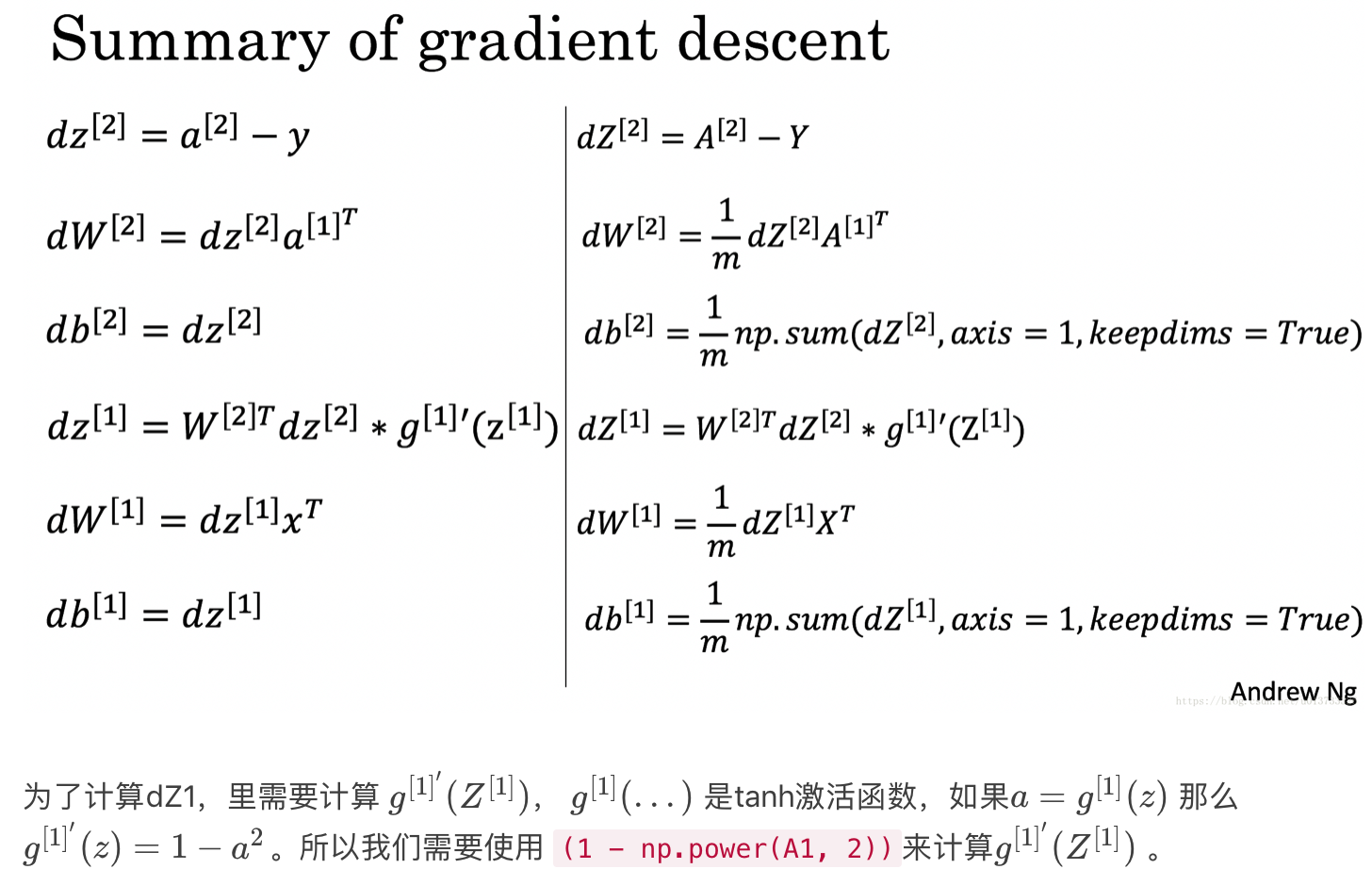
代码:
def backward_propagation(parameters,cache,X,Y): """ 使用上述说明搭建反向传播函数。 参数: parameters - 包含我们的参数的一个字典类型的变量。 cache - 包含“Z1”,“A1”,“Z2”和“A2”的字典类型的变量。 X - 输入数据,维度为(2,数量) Y - “True”标签,维度为(1,数量) 返回: grads - 包含W和b的导数一个字典类型的变量。 """ m = X.shape[1] W1 = parameters["W1"] W2 = parameters["W2"] A1 = cache["A1"] A2 = cache["A2"] dZ2= A2 - Y dW2 = (1 / m) * np.dot(dZ2, A1.T) db2 = (1 / m) * np.sum(dZ2, axis=1, keepdims=True) dZ1 = np.multiply(np.dot(W2.T, dZ2), 1 - np.power(A1, 2)) dW1 = (1 / m) * np.dot(dZ1, X.T) db1 = (1 / m) * np.sum(dZ1, axis=1, keepdims=True) grads = {"dW1": dW1, "db1": db1, "dW2": dW2, "db2": db2 } return grads #测试backward_propagation print("=========================测试backward_propagation=========================") def backward_propagation_test_case(): np.random.seed(1) X_assess = np.random.randn(2, 3) #随机生成与上面相同的输入X Y_assess = np.random.randn(1, 3) #随机生成与上面相同的输出Y parameters = {'W1': np.array([[-0.00416758, -0.00056267], #将之前测试初始化参数时得到的值作为参数 [-0.02136196, 0.01640271], [-0.01793436, -0.00841747], [ 0.00502881, -0.01245288]]), 'W2': np.array([[-0.01057952, -0.00909008, 0.00551454, 0.02292208]]), 'b1': np.array([[ 0.], [ 0.], [ 0.], [ 0.]]), 'b2': np.array([[ 0.]])} cache = {'A1': np.array([[-0.00616578, 0.0020626 , 0.00349619], #之前前向传播时存储在cache中的值 [-0.05225116, 0.02725659, -0.02646251], [-0.02009721, 0.0036869 , 0.02883756], [ 0.02152675, -0.01385234, 0.02599885]]), 'A2': np.array([[ 0.5002307 , 0.49985831, 0.50023963]]), 'Z1': np.array([[-0.00616586, 0.0020626 , 0.0034962 ], [-0.05229879, 0.02726335, -0.02646869], [-0.02009991, 0.00368692, 0.02884556], [ 0.02153007, -0.01385322, 0.02600471]]), 'Z2': np.array([[ 0.00092281, -0.00056678, 0.00095853]])} return parameters, cache, X_assess, Y_assess parameters, cache, X_assess, Y_assess = backward_propagation_test_case() grads = backward_propagation(parameters, cache, X_assess, Y_assess) print ("dW1 = "+ str(grads["dW1"])) print ("db1 = "+ str(grads["db1"])) print ("dW2 = "+ str(grads["dW2"])) print ("db2 = "+ str(grads["db2"]))
返回:
=========================测试backward_propagation========================= dW1 = [[ 0.01018708 -0.00708701] [ 0.00873447 -0.0060768 ] [-0.00530847 0.00369379] [-0.02206365 0.01535126]] db1 = [[-0.00069728] [-0.00060606] [ 0.000364 ] [ 0.00151207]] dW2 = [[ 0.00363613 0.03153604 0.01162914 -0.01318316]] db2 = [[0.06589489]]
反向传播完成了,我们开始对参数进行更新
8.更新参数w,b
我们需要使用(dW1, db1, dW2, db2)来更新(W1, b1, W2, b2)
更新算法如下:
θ=θ−α(∂J/∂θ)
- α:学习速率
- θ :参数
def update_parameters(parameters,grads,learning_rate=1.2): """ 使用上面给出的梯度下降更新规则更新参数 参数: parameters - 包含参数的字典类型的变量。 grads - 包含导数值的字典类型的变量。 learning_rate - 学习速率 返回: parameters - 包含更新参数的字典类型的变量。 """ W1,W2 = parameters["W1"],parameters["W2"] b1,b2 = parameters["b1"],parameters["b2"] dW1,dW2 = grads["dW1"],grads["dW2"] db1,db2 = grads["db1"],grads["db2"] W1 = W1 - learning_rate * dW1 b1 = b1 - learning_rate * db1 W2 = W2 - learning_rate * dW2 b2 = b2 - learning_rate * db2 parameters = {"W1": W1, "b1": b1, "W2": W2, "b2": b2} return parameters #测试update_parameters print("=========================测试update_parameters=========================") def update_parameters_test_case(): parameters = {'W1': np.array([[-0.00615039, 0.0169021 ], #将之前测试初始化参数时得到的值作为参数 [-0.02311792, 0.03137121], [-0.0169217 , -0.01752545], [ 0.00935436, -0.05018221]]), 'W2': np.array([[-0.0104319 , -0.04019007, 0.01607211, 0.04440255]]), 'b1': np.array([[ -8.97523455e-07], [ 8.15562092e-06], [ 6.04810633e-07], [ -2.54560700e-06]]), 'b2': np.array([[ 9.14954378e-05]])} grads = {'dW1': np.array([[ 0.00023322, -0.00205423], [ 0.00082222, -0.00700776], [-0.00031831, 0.0028636 ], [-0.00092857, 0.00809933]]), 'dW2': np.array([[ -1.75740039e-05, 3.70231337e-03, -1.25683095e-03, -2.55715317e-03]]), 'db1': np.array([[ 1.05570087e-07], [ -3.81814487e-06], [ -1.90155145e-07], [ 5.46467802e-07]]), 'db2': np.array([[ -1.08923140e-05]])} return parameters, grads parameters, grads = update_parameters_test_case() parameters = update_parameters(parameters, grads) print("W1 = " + str(parameters["W1"])) print("b1 = " + str(parameters["b1"])) print("W2 = " + str(parameters["W2"])) print("b2 = " + str(parameters["b2"]))
9.整合上面的所有函数
使神经网络模型以正确的顺序使用先前的函数功能,整合在nn_model()函数中
def nn_model(X,Y,n_h,num_iterations,print_cost=False): """ 参数: X - 数据集,维度为(2,示例数) Y - 标签,维度为(1,示例数) n_h - 隐藏层的数量 num_iterations - 梯度下降循环中的迭代次数 print_cost - 如果为True,则每1000次迭代打印一次成本数值 返回: parameters - 模型学习的参数,它们可以用来进行预测。 """ np.random.seed(3) #指定随机种子 n_x = layer_sizes(X, Y)[0] n_y = layer_sizes(X, Y)[2] parameters = initialize_parameters(n_x,n_h,n_y) W1 = parameters["W1"] b1 = parameters["b1"] W2 = parameters["W2"] b2 = parameters["b2"] for i in range(num_iterations): #多次迭代,更新w,b,求出相应的成本函数 A2 , cache = forward_propagation(X,parameters) #先前向传播,得到结果A2以及将相应的数据存储到cache中 cost = compute_cost(A2,Y,parameters) #根据得到的结果A2和真正的结果Y去计算成本 grads = backward_propagation(parameters,cache,X,Y) #然后计算相应参数的梯度 parameters = update_parameters(parameters,grads,learning_rate = 0.5) #根据梯度去更新参数 if print_cost: if i%1000 == 0: #1000次迭代后输出一次成本查看成本的变化 print("第 ",i," 次循环,成本为:"+str(cost)) return parameters
10.预测
使用上面训练好的参数w,b对测试集进行预测
输出y大于0.5则为蓝色,小于0.5则为红色
def predict(parameters,X): """ 使用学习的参数,为X中的每个示例预测一个类 参数: parameters - 包含参数的字典类型的变量,这是训练好的参数 X - 输入数据(n_x,m) 返回 predictions - 我们模型预测的向量(红色:0 /蓝色:1) """ #使用训练好的参数去前向传播获取预测值 A2 , cache = forward_propagation(X,parameters) predictions = np.round(A2) return predictions
11.整个代码运行
如果直接将整个函数放入jupyter notebook中总会报错:
ValueError: 'c' argument has 1 elements, which is not acceptable for use with 'x' with size 400, 'y' with size 400.
即使把planar_utils.py文件中的plot_decision_boundary()函数中的语句改成:
plt.scatter(X[0, :], X[1, :], c=np.squeeze(y), cmap=plt.cm.Spectral)
也不行,后面拆开导入就成功了:
import numpy as np import matplotlib.pyplot as plt from testCases import * import sklearn import sklearn.datasets import sklearn.linear_model def plot_decision_boundary(model, X, y): #用于绘制logistic的线形分类线 # Set min and max values and give it some padding x_min, x_max = X[0, :].min() - 1, X[0, :].max() + 1 y_min, y_max = X[1, :].min() - 1, X[1, :].max() + 1 h = 0.01 # Generate a grid of points with distance h between them xx, yy = np.meshgrid(np.arange(x_min, x_max, h), np.arange(y_min, y_max, h)) # Predict the function value for the whole grid Z = model(np.c_[xx.ravel(), yy.ravel()]) Z = Z.reshape(xx.shape) # Plot the contour and training examples plt.contourf(xx, yy, Z, cmap=plt.cm.Spectral) plt.ylabel('x2') plt.xlabel('x1') plt.scatter(X[0, :], X[1, :], c=np.squeeze(y), cmap=plt.cm.Spectral)
from planar_utils import sigmoid, load_planar_dataset, load_extra_datasets np.random.seed(1) #设置一个固定的随机种子,以保证接下来的步骤中我们的结果是一致的。 X, Y = load_planar_dataset() #plt.scatter(X[0, :], X[1, :], c=Y, s=40, cmap=plt.cm.Spectral) #绘制散点图 shape_X = X.shape shape_Y = Y.shape m = Y.shape[1] # 训练集里面的数量 print ("X的维度为: " + str(shape_X)) print ("Y的维度为: " + str(shape_Y)) print ("数据集里面的数据有:" + str(m) + " 个") def layer_sizes(X , Y): """ 参数: X - 输入数据集,维度为(输入的数量,训练/测试的数量) Y - 标签,维度为(输出的数量,训练/测试数量) 返回: n_x - 输入层的数量 n_h - 隐藏层的数量 n_y - 输出层的数量 """ n_x = X.shape[0] #输入层 n_h = 4 #,隐藏层,硬编码为4 n_y = Y.shape[0] #输出层 return (n_x,n_h,n_y) def initialize_parameters( n_x , n_h ,n_y): """ 参数: n_x - 输入节点的数量 n_h - 隐藏层节点的数量 n_y - 输出层节点的数量 返回: parameters - 包含参数的字典: W1 - 权重矩阵,维度为(n_h,n_x) b1 - 偏向量,维度为(n_h,1) W2 - 权重矩阵,维度为(n_y,n_h) b2 - 偏向量,维度为(n_y,1) """ np.random.seed(2) #指定一个随机种子,以便你的输出与我们的一样。 W1 = np.random.randn(n_h,n_x) * 0.01 b1 = np.zeros(shape=(n_h, 1)) W2 = np.random.randn(n_y,n_h) * 0.01 b2 = np.zeros(shape=(n_y, 1)) #使用断言确保我的数据格式是正确的 assert(W1.shape == ( n_h , n_x )) assert(b1.shape == ( n_h , 1 )) assert(W2.shape == ( n_y , n_h )) assert(b2.shape == ( n_y , 1 )) parameters = {"W1" : W1, "b1" : b1, "W2" : W2, "b2" : b2 } return parameters def forward_propagation( X , parameters ): """ 参数: X - 维度为(n_x,m)的输入数据。 parameters - 初始化函数(initialize_parameters)的输出 返回: A2 - 使用sigmoid()函数计算的第二次激活后的数值 cache - 包含“Z1”,“A1”,“Z2”和“A2”的字典类型变量 """ W1 = parameters["W1"] b1 = parameters["b1"] W2 = parameters["W2"] b2 = parameters["b2"] #前向传播计算A2 Z1 = np.dot(W1 , X) + b1 A1 = np.tanh(Z1) Z2 = np.dot(W2 , A1) + b2 A2 = sigmoid(Z2) #使用断言确保我的数据格式是正确的 assert(A2.shape == (1,X.shape[1])) cache = {"Z1": Z1, "A1": A1, "Z2": Z2, "A2": A2} return (A2, cache) def compute_cost(A2,Y,parameters): """ 计算方程(6)中给出的交叉熵成本, 参数: A2 - 使用sigmoid()函数计算的第二次激活后的数值 Y - "True"标签向量,维度为(1,数量) parameters - 一个包含W1,B1,W2和B2的字典类型的变量 返回: 成本 - 交叉熵成本给出方程(13) """ m = Y.shape[1] W1 = parameters["W1"] W2 = parameters["W2"] #计算成本 logprobs = logprobs = np.multiply(np.log(A2), Y) + np.multiply((1 - Y), np.log(1 - A2)) cost = - np.sum(logprobs) / m cost = float(np.squeeze(cost)) assert(isinstance(cost,float)) return cost def backward_propagation(parameters,cache,X,Y): """ 使用上述说明搭建反向传播函数。 参数: parameters - 包含我们的参数的一个字典类型的变量。 cache - 包含“Z1”,“A1”,“Z2”和“A2”的字典类型的变量。 X - 输入数据,维度为(2,数量) Y - “True”标签,维度为(1,数量) 返回: grads - 包含W和b的导数一个字典类型的变量。 """ m = X.shape[1] W1 = parameters["W1"] W2 = parameters["W2"] A1 = cache["A1"] A2 = cache["A2"] dZ2= A2 - Y dW2 = (1 / m) * np.dot(dZ2, A1.T) db2 = (1 / m) * np.sum(dZ2, axis=1, keepdims=True) dZ1 = np.multiply(np.dot(W2.T, dZ2), 1 - np.power(A1, 2)) dW1 = (1 / m) * np.dot(dZ1, X.T) db1 = (1 / m) * np.sum(dZ1, axis=1, keepdims=True) grads = {"dW1": dW1, "db1": db1, "dW2": dW2, "db2": db2 } return grads def update_parameters(parameters,grads,learning_rate=1.2): """ 使用上面给出的梯度下降更新规则更新参数 参数: parameters - 包含参数的字典类型的变量。 grads - 包含导数值的字典类型的变量。 learning_rate - 学习速率 返回: parameters - 包含更新参数的字典类型的变量。 """ W1,W2 = parameters["W1"],parameters["W2"] b1,b2 = parameters["b1"],parameters["b2"] dW1,dW2 = grads["dW1"],grads["dW2"] db1,db2 = grads["db1"],grads["db2"] W1 = W1 - learning_rate * dW1 b1 = b1 - learning_rate * db1 W2 = W2 - learning_rate * dW2 b2 = b2 - learning_rate * db2 parameters = {"W1": W1, "b1": b1, "W2": W2, "b2": b2} return parameters def nn_model(X,Y,n_h,num_iterations,print_cost=False): """ 参数: X - 数据集,维度为(2,示例数) Y - 标签,维度为(1,示例数) n_h - 隐藏层的数量 num_iterations - 梯度下降循环中的迭代次数 print_cost - 如果为True,则每1000次迭代打印一次成本数值 返回: parameters - 模型学习的参数,它们可以用来进行预测。 """ np.random.seed(3) #指定随机种子 n_x = layer_sizes(X, Y)[0] n_y = layer_sizes(X, Y)[2] parameters = initialize_parameters(n_x,n_h,n_y) W1 = parameters["W1"] b1 = parameters["b1"] W2 = parameters["W2"] b2 = parameters["b2"] for i in range(num_iterations): #多次迭代,更新w,b,求出相应的成本函数 A2 , cache = forward_propagation(X,parameters) #先前向传播,得到结果A2以及将相应的数据存储到cache中 cost = compute_cost(A2,Y,parameters) #根据得到的结果A2和真正的结果Y去计算成本 grads = backward_propagation(parameters,cache,X,Y) #然后计算相应参数的梯度 parameters = update_parameters(parameters,grads,learning_rate = 0.5) #根据梯度去更新参数 if print_cost: if i%1000 == 0: #1000次迭代后输出一次成本查看成本的变化 print("第 ",i," 次循环,成本为:"+str(cost)) return parameters def predict(parameters,X): """ 使用学习的参数w,b,为X中的每个示例预测一个类 参数: parameters - 包含参数的字典类型的变量。 X - 输入数据(n_x,m) 返回 predictions - 我们模型预测的向量(红色:0 /蓝色:1) """ A2 , cache = forward_propagation(X,parameters) predictions = np.round(A2) return predictions
返回:
X的维度为: (2, 400) Y的维度为: (1, 400) 数据集里面的数据有:400 个
然后运行:
parameters = nn_model(X, Y, n_h = 4, num_iterations=10000, print_cost=True) #绘制边界 plot_decision_boundary(lambda x: predict(parameters, x.T), X, Y) plt.title("Decision Boundary for hidden layer size " + str(4)) predictions = predict(parameters, X) print ('准确率: %d' % float((np.dot(Y, predictions.T) + np.dot(1 - Y, 1 - predictions.T)) / float(Y.size) * 100) + '%')
返回:
第 0 次循环,成本为:0.6930480201239823 第 1000 次循环,成本为:0.3098018601352803 第 2000 次循环,成本为:0.2924326333792646 第 3000 次循环,成本为:0.2833492852647412 第 4000 次循环,成本为:0.27678077562979253 第 5000 次循环,成本为:0.26347155088593194 第 6000 次循环,成本为:0.2420441312994077 第 7000 次循环,成本为:0.23552486626608765 第 8000 次循环,成本为:0.23140964509854278 第 9000 次循环,成本为:0.22846408048352365 准确率: 90%
图示为:
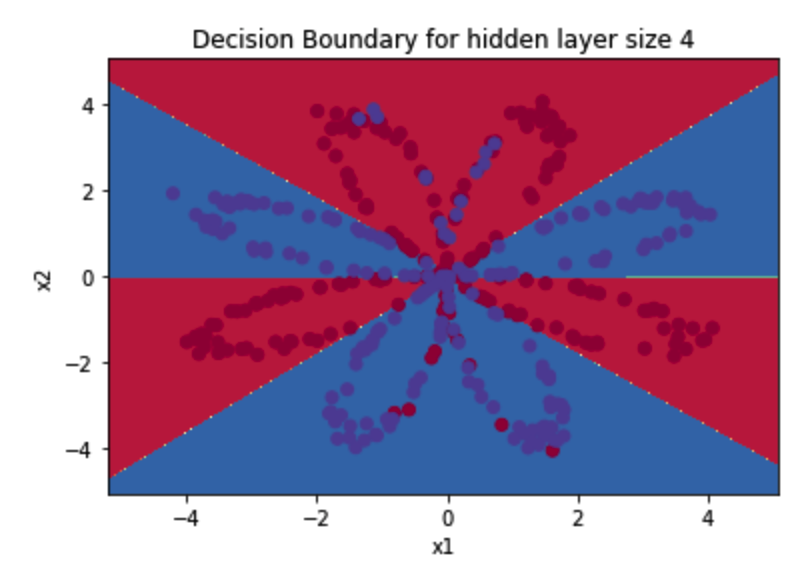
12.优化
1)更改隐藏层神经元数量
plt.figure(figsize=(16, 32)) hidden_layer_sizes = [1, 2, 3, 4, 5, 20, 50] #更改隐藏层数量 for i, n_h in enumerate(hidden_layer_sizes): plt.subplot(5, 2, i + 1) plt.title('Hidden Layer of size %d' % n_h) parameters = nn_model(X, Y, n_h, num_iterations=5000) plot_decision_boundary(lambda x: predict(parameters, x.T), X, Y) predictions = predict(parameters, X) accuracy = float((np.dot(Y, predictions.T) + np.dot(1 - Y, 1 - predictions.T)) / float(Y.size) * 100) print ("隐藏层的节点数量: {} ,准确率: {} %".format(n_h, accuracy))
返回:
隐藏层的节点数量: 1 ,准确率: 67.25 % 隐藏层的节点数量: 2 ,准确率: 66.5 % 隐藏层的节点数量: 3 ,准确率: 89.25 % 隐藏层的节点数量: 4 ,准确率: 90.0 % 隐藏层的节点数量: 5 ,准确率: 89.75 % 隐藏层的节点数量: 20 ,准确率: 90.0 % 隐藏层的节点数量: 50 ,准确率: 89.75 %
图示:
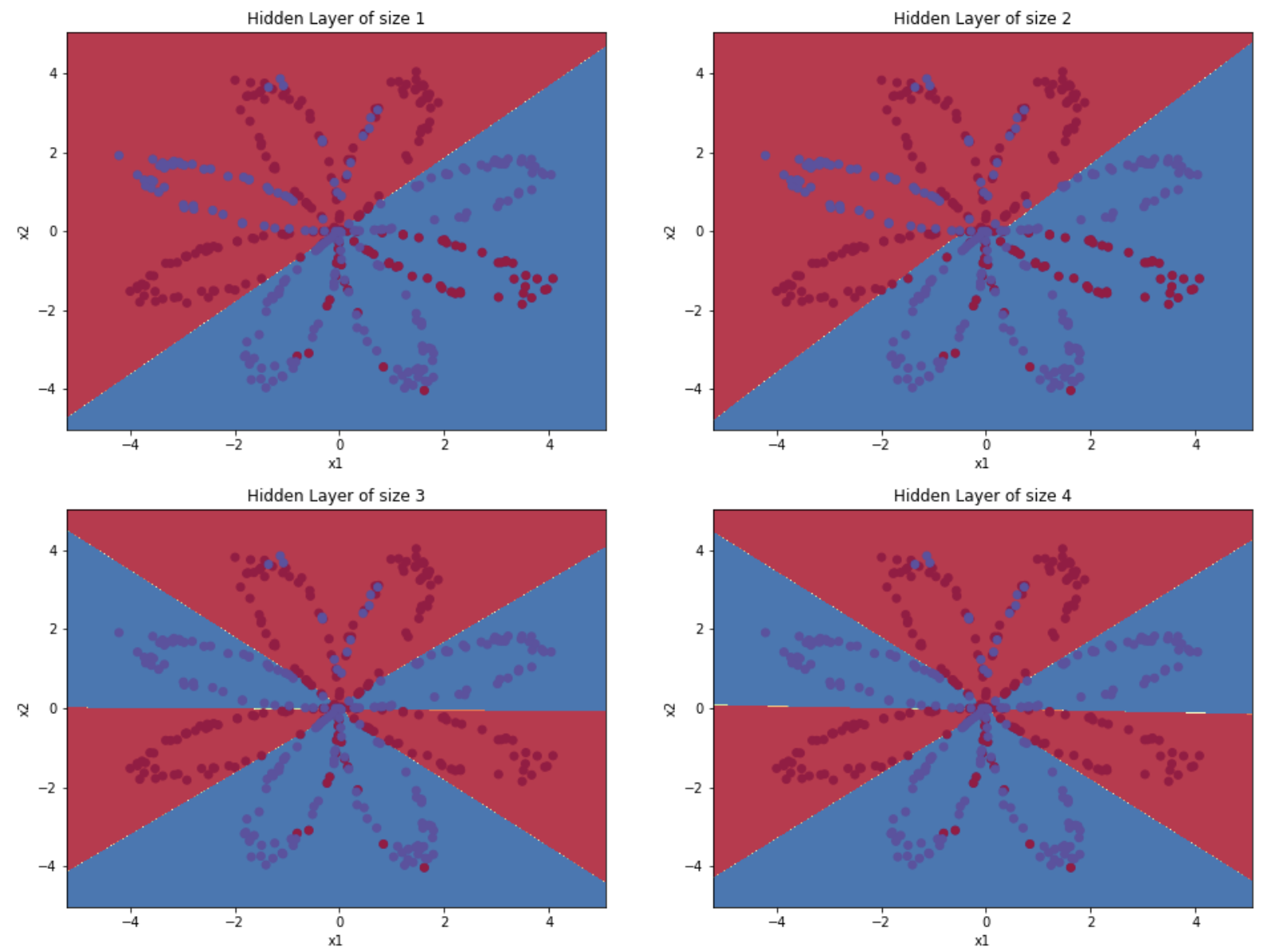
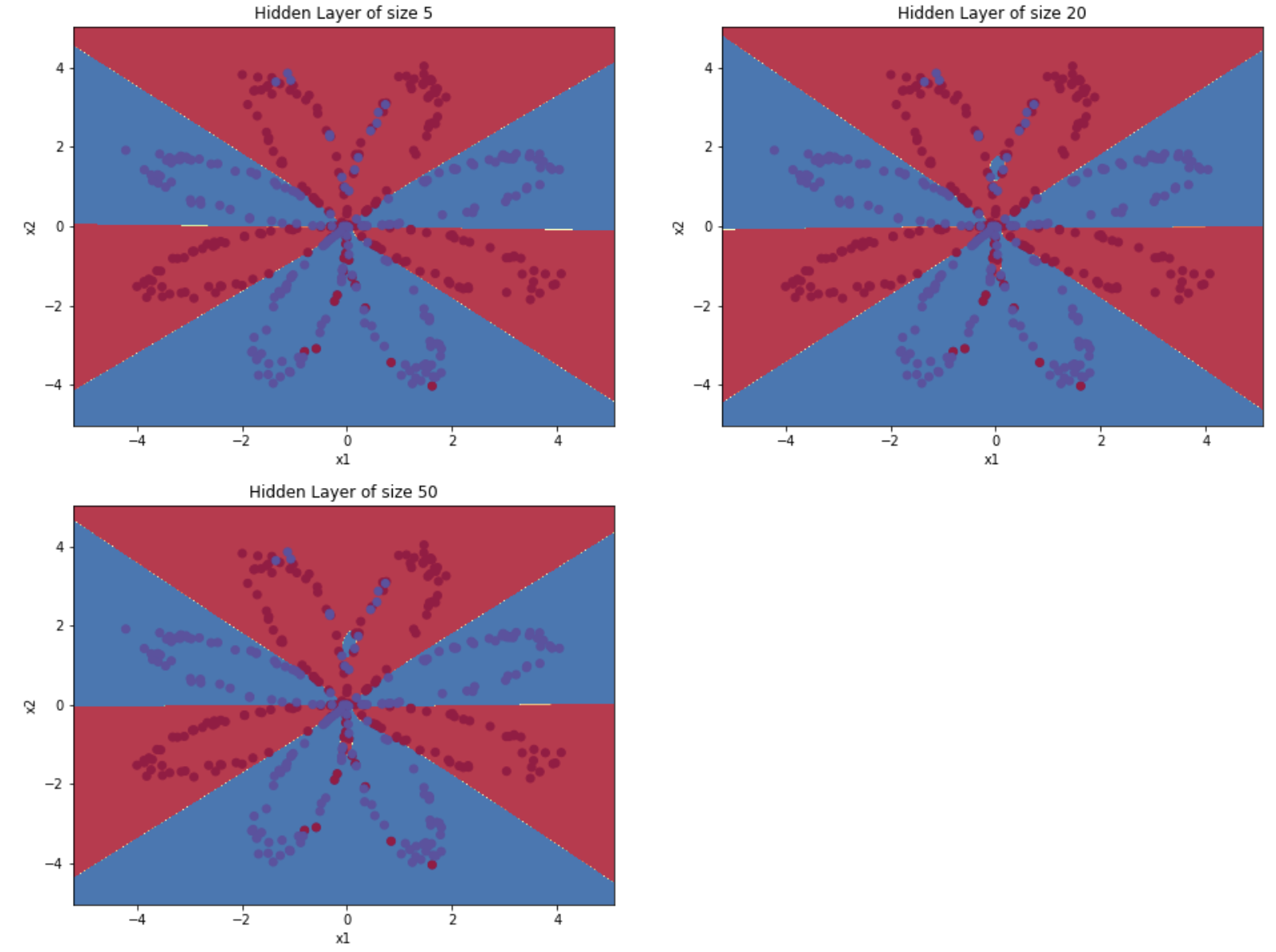
较大的模型(具有更多隐藏单元)能够更好地适应训练集,直到最终的最大模型过度拟合数据。
最好的隐藏层大小似乎在n_h = 4附近。实际上,这里的值似乎很适合数据,而且不会引起过度拟合。
我们还将在后面学习有关正则化的知识,它允许我们使用非常大的模型(如n_h = 50),而不会出现太多过度拟合。
2)如果更改的是学习率:
将函数更改为:
def nn_model(X,Y,n_h,num_iterations,lr,print_cost=False): #添加学习率lr """ 参数: X - 数据集,维度为(2,示例数) Y - 标签,维度为(1,示例数) n_h - 隐藏层的数量 num_iterations - 梯度下降循环中的迭代次数 print_cost - 如果为True,则每1000次迭代打印一次成本数值 返回: parameters - 模型学习的参数,它们可以用来进行预测。 """ np.random.seed(3) #指定随机种子 n_x = layer_sizes(X, Y)[0] n_y = layer_sizes(X, Y)[2] parameters = initialize_parameters(n_x,n_h,n_y) W1 = parameters["W1"] b1 = parameters["b1"] W2 = parameters["W2"] b2 = parameters["b2"] for i in range(num_iterations): A2 , cache = forward_propagation(X,parameters) cost = compute_cost(A2,Y,parameters) grads = backward_propagation(parameters,cache,X,Y) parameters = update_parameters(parameters,grads,learning_rate = lr) #学习率根据输入进行变化 if print_cost: if i%1000 == 0: print("第 ",i," 次循环,成本为:"+str(cost)) return parameters
测试:
plt.figure(figsize=(16, 32)) lrs = [0.1,0.2,0.3,0.4,0.5,0.6,0.7,0.8,0.9] #更改隐藏层数量 for i, lr in enumerate(lrs): plt.subplot(5, 2, i + 1) plt.title('learning rate is: %f' % lr) parameters = nn_model(X, Y, n_h = 4,num_iterations=5000,lr = lr) plot_decision_boundary(lambda x: predict(parameters, x.T), X, Y) predictions = predict(parameters, X) accuracy = float((np.dot(Y, predictions.T) + np.dot(1 - Y, 1 - predictions.T)) / float(Y.size) * 100) print ("学习率为: {} ,准确率: {} %".format(lr, accuracy))
返回:
学习率为: 0.1 ,准确率: 88.0 % 学习率为: 0.2 ,准确率: 89.25 % 学习率为: 0.3 ,准确率: 89.5 % 学习率为: 0.4 ,准确率: 89.5 % 学习率为: 0.5 ,准确率: 90.0 % 学习率为: 0.6 ,准确率: 90.25 % 学习率为: 0.7 ,准确率: 90.5 % 学习率为: 0.8 ,准确率: 90.5 % 学习率为: 0.9 ,准确率: 90.5 %
图示为:

